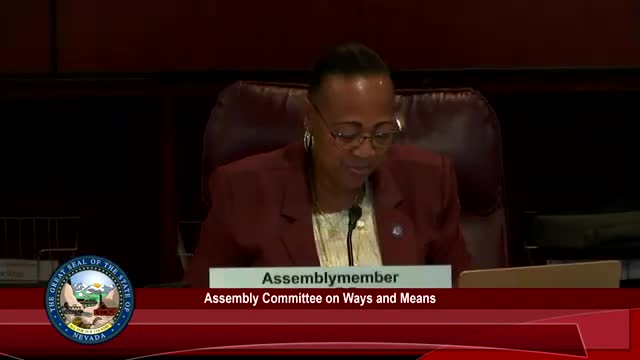Assembly member Slayton Torres Fossett presents Nevada's Teaching Beyond Testing Act
May 20, 2025 | 2025 Legislature NV, Nevada
This article was created by AI summarizing key points discussed. AI makes mistakes, so for full details and context, please refer to the video of the full meeting. Please report any errors so we can fix them. Report an error »

In a recent meeting of the Assembly Committee on Ways and Means, lawmakers discussed Assembly Bill 286, known as the Teaching Beyond Testing Act. This proposed legislation aims to create a pilot program within Nevada's higher education institutions to evaluate the competency of teaching license applicants through alternative assessment methods, rather than solely relying on traditional testing.
Assembly Member Slayton Torres Fossett introduced the bill, highlighting its potential to streamline the licensing process for teachers. Currently, applicants who do not pass competency tests, such as the Praxis core, are often required to retake classes they have already completed. The new bill seeks to eliminate this redundancy by allowing applicants to use their previous coursework to demonstrate competency, thereby reducing unnecessary barriers to entry into the teaching profession.
The bill also mandates that participating institutions submit annual reports on the program's progress, ensuring accountability and transparency. While there is a fiscal note associated with the bill, indicating a cost of $6,250 for the 2026-2027 fiscal year, it is important to note that the original appropriation was removed. This means that the bill provides permissive language for the Nevada System of Higher Education (NSHE) to establish these programs without a guaranteed state funding commitment.
The discussions surrounding Assembly Bill 286 reflect a broader trend in education policy aimed at making teacher licensure more accessible and responsive to the needs of both educators and students. By focusing on competency rather than standardized testing, the bill could pave the way for a more diverse and capable teaching workforce in Nevada.
As the committee continues to evaluate this and other legislative measures, the implications of such reforms could significantly impact the future of education in the state, particularly in addressing teacher shortages and improving educational outcomes. The next steps will involve further deliberation and potential amendments to the bill as it moves through the legislative process.
Assembly Member Slayton Torres Fossett introduced the bill, highlighting its potential to streamline the licensing process for teachers. Currently, applicants who do not pass competency tests, such as the Praxis core, are often required to retake classes they have already completed. The new bill seeks to eliminate this redundancy by allowing applicants to use their previous coursework to demonstrate competency, thereby reducing unnecessary barriers to entry into the teaching profession.
The bill also mandates that participating institutions submit annual reports on the program's progress, ensuring accountability and transparency. While there is a fiscal note associated with the bill, indicating a cost of $6,250 for the 2026-2027 fiscal year, it is important to note that the original appropriation was removed. This means that the bill provides permissive language for the Nevada System of Higher Education (NSHE) to establish these programs without a guaranteed state funding commitment.
The discussions surrounding Assembly Bill 286 reflect a broader trend in education policy aimed at making teacher licensure more accessible and responsive to the needs of both educators and students. By focusing on competency rather than standardized testing, the bill could pave the way for a more diverse and capable teaching workforce in Nevada.
As the committee continues to evaluate this and other legislative measures, the implications of such reforms could significantly impact the future of education in the state, particularly in addressing teacher shortages and improving educational outcomes. The next steps will involve further deliberation and potential amendments to the bill as it moves through the legislative process.
View full meeting
This article is based on a recent meeting—watch the full video and explore the complete transcript for deeper insights into the discussion.
View full meeting